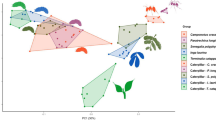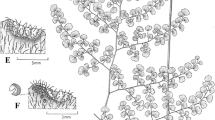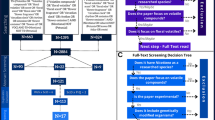Abstract
Colleters are secretory structures that produce and release mucilage or a mucilage-resin mixture protecting meristems and young structures against desiccation, herbivores, and pathogens. The secretions may vary in colleters of same or different types, indicating that the functionality of colleters may be more specific than previously thought. In this study, we compared 17 Rubiaceae species from savanna and forest environment focusing on colleter secretions and its ecological role. First, we evaluated the morphology, distribution, and histochemistry of stipular colleters using light and scanning electron microscopy. Additionally, we investigated the phenology, microclimate, and the proportion of damaged apices in the savanna and forest species. We recorded standard-type colleters, variable in distribution and size, in 14 of the 17 studied species. The secretion varied from predominantly hydrophilic, mixed to predominantly lipophilic. During the budding period, secretion covered the vegetative apices. Savanna species had a prevalence of lipid secretion in habitats with higher luminosity, which had a lower proportion of damaged apices. In contrast, forest species occurred in habitats with lower luminosity and had a higher proportion of damaged apices, in general with the absence of lipids in the colleters. These results highlight that colleters with similar morphology clearly differed in secretions among species, especially between species from savanna and forest, in which the colleters appear potentially associated with protection against irradiation in savanna, but not in the forest environment.








Similar content being viewed by others
References
Agostinelli C, Lund U (2011). R package ‘circular’: Circular Statistics (version 0.4–3). R-project website Available: https://r-forge.r-project.org/projects/circular/. Accessed 2014 Sep 23.
Aiello A (1979) A reexamination of Portlandia (Rubiaceae) and associated taxa. J Arnold Arboretum 60:38–123
Barreiro DP, Machado SR (2007) Coléteres dendroides em Cordiera sessilis (Vell.) K. Schum., uma espécie não-nodulada de Rubiaceae. Rev Bras Bot 30:387–399
Batschelet E (1981) Circular statistics in biology. Academic, New York
Carlquist S (1969) Toward acceptable evolutionary interpretations of floral anatomy. Phytomorphology 19:332–362
Coley PD, Kursar TA (1996) Anti-herbivore defences of young tropical leaves: physiological constrains and ecological tradeoffs. Tropical Forest Plant Ecophysiology (eds SS Mulkey and RL Chazdon), pp 305–336.
Cortelazzo AL (1992) Detecção e quantificação do amido em cotilédones de Canavalia ensiformis e C. gladiata durante o desenvolvimento inicial da planta. Rev Bras Bot 15:157–162
Coutinho LM (1978) O conceito de cerrado. Rev Bras Bot 1(1):17–23
Coutinho LM (2002) O bioma do cerrado. In: Klein AL (ed) Eugen Warming e o cerrado brasileiro: um século depois. São Paulo, Editora da Unesp, pp 77–91
Cunha AR, Martins D (2009) Classificação climática para os municípios de Botucatu e São Manuel-SP. Irriga 14(1):1–11
Delprete PG, Jardim JG (2012) Systematics, taxonomy and floristics of Brazilian Rubiaceae: an overview about the current status and future challenge. Rodriguésia 63:101–128
Evert RF (2006) Esau’s plant anatomy, meristems, cells, and tissues of the plant body: their structure, function, and development. 3rd edn. Wiley, New Jersey
Fahn A (1979) Secretory tissues in plants. Academic, London
Fahn A (1990) Plant anatomy. Pergamon, Oxford
Fournier LA (1974) Un método cuantitativo para la medición de características fenológicas en árboles. Turrialba 24:422–423
Franceschi VR, Nakata PA (2005) Calcium oxalate in plants: formation and function. Ann Rev Plant Biol 56:41–71
Harborne JB, Baxter H, Moss GP (1999) Phytochemical dictionary: a handbook of bioactive compounds from plants, 2nd edn. Taylor and Francis, London
Jammalamadaka SR, SenGupta A (2001) Topics in circular statistics. World Scientific, New York
Jensen WA (1962) Botanical histochemistry: principles and practice. W. H. Freeman and Co., San Francisco
Johansen DA (1940) Plant microtechnique. Paul B. Hoeber, Inc., New York
Karnovsky MJ (1965) A formaldehyde-glutaraldehyde fixative in high osmolality for use in electron microscopy. J Cell Biol 27:137A–138A
Klein DE, Gomes VM, Silva-Neto SJ, Cunha M (2004) The structure of colleters in several species of Simira (Rubiaceae). Ann Bot 94:733–740
Kronestedt-Robards E, Robards A (1991) Exocytosis in gland cells. In: Hawea C, Coleman J, Evans D (eds) Endocytosis, exocytosis and vesicle traffic in plants. Cambridge University Press, Cambridge, pp 199–232
Lersten NR (1974) Morphology and distribution of colleters and crystals in relation to the taxonomy and bacterial leaf nodules symbiosis of Psychotria (Rubiaceae). Am J Bot 61(9):973–981
Lersten NR (1975) Colleter types in Rubiaceae, especially in relation to the bacterial leaf nodule symbiosis. Bot J Lin Soc 71:311–319
Mayer JMS, Carmello-Guerreiro SM, Mazzafera P (2013) A functional role for the colleters of coffee flowers. Ann Bot 5: plt029. doi:10.1093/aobpla/plt029.
Mazia D, Brewer PA, Alfert M (1953) The cytochemical staining and measurement of protein with mercuric bromophenol blue. The Biol Bull 104:57–67
Melo MO, Silva-Filho MC (2002) Plant-insect interaction: an evolutionary arms race between two distinct defense mechanisms. Braz J Plant Physiol 14:71–81
Miguel EC, Moraes DG, Da Cunha M (2009) Stipular colleters in Psychotria nuda (Cham. e Schltdl.) Wawra (Rubiaceae): micromorphology, anatomy and cristals microanalysis. Acta Bot Bras 23:1034–1039
Miguel EC, Klein DE, Oliveira MA, Cunha M (2010) Ultrastructure of secretory and senescence phase in colleters of Bathysa gymnocarpa and B. stipulate (Rubiaceae). Rev Bras Bot 33:425–436
Neves FS, Araújo LS, Espírito-Santo MM, Fagundes M, Fernandes GW, Sanchez-Azofeifa GA, Quesada M (2010) Canopy herbivory and insect herbivore diversity in a dry forest-savanna transition in Brazil. Biotropica 42(1):112–118
Nicolson SW, Nepi M, Pacini W (2007) Nectaries and nectar. Springer, Dordrecht, The Netherlands
Paiva EAS (2012) Colleters in Cariniana estrellensis (Lecythidaceae): structure, secretion and evidences for young leaf protection. J Torrey Bot Soc 139:1–8
Pearse AGE (1980) Histochemistry, theoretical and applied: preparative and optical technology. 4th ed. Churchill Livingston, Edinburgh
Pinheiro MHO, Monteiro R (2010) Contribution to the discussions on the origin of the cerrado biome: Brazilian savanna. Braz J Biol 70:95–102
Pizzolato TD, Lillie RD (1973) Mayer’s tannicacid-ferric chloride stain for mucins. The Journal of Histochemistry and Cytochemistry 21:56–64
Reich PB, Borchert R (1984) Water stress and tree phenology in a tropical dry forest in the lowlands of Costa Rica. J Ecol 72:61–74
Robards AW (1978) An introduction to techniques for scanning electron microscopy of plant cells. In: Hall JL (ed) Electron microscopy and cytochemistry of plant cells. Elsevier, New York, pp 343–403
Robbrecht E (1988) Tropical woody Rubiaceae. Characteristic features and progressions. Contributions to a new subfamilial classification. Opera Botanica Belgica 1:1–271
Scariot A, Sevilha AC (2005) Biodiversidade, estrutura e conservação de florestas estacionais deciduais no Cerrado. In: A Scariot et al. (eds) Cerrado: ecologia, biodiversidade e conservação. Brasília, DF: Ministério do Meio Ambiente, pp 121–139
Souza VC, Lorenzi H (2005) Botânica sistemática: guia ilustrado para identificação das famílias de Angiospermas da flora brasileira, baseado em APG II. Instituto Plantarum, Nova Odessa
Svendsen AB, Verpoorte R (1983) Cromatography of alkaloids. Elsevier Scientific, New York
Thomas V (1991) Structural, functional and phylogenetic aspects of the colleters. Ann Bot 68:287–305
Trigo JR, Pareja M, Massuda KF (2012) O papel das substâncias químicas nas interações entre plantas e insetos herbívoros. In: Del-Claro K, Torezan-Silingardi HM (eds) Ecologia das interações plantas-animais: uma abordagem ecológico-evolutivo. Technical Books Editora, Rio de Janeiro, pp 67–88
Vitarelli NC, Santos M (2009) Anatomia de estípulas e coléteres de Psychotria cartagenensis Jacq. (Rubiaceae). Acta Bot Bras 23:923–928
Walter H, Lieth H (1967) Klimadiagramamm-Weltatlos. Pusl. Gustav Fischer, Jena
Wright SJ (1991) Seasonal drought and the phenology of understory shrubs in a tropical moist forest. Ecology 72:1643–1657
Zar JH (2010) Biostatistical analysis. 5th edn. Prentice Hill.
Acknowledgments
This article is part of the doctoral thesis of F. Tresmondi funded by the ‘Fundação de Amparo à Pesquisa do Estado de São Paulo’ (FAPESP 2008/55434-7 and grant 2011/02488-5) and by the ‘Conselho Nacional de Desenvolvimento Científico e Tecnológico’ (CNPq 473289/2010 and granted to Machado, S.R.). We thank Yve Canaveze for the help in the preparation of figures and text revision, Priscila T. Tunes for language editing, Danilo Silva and Daniella Vinha for suggestion on statistical analysis, and the staff of ‘Centro de Microscopia Eletrônica (IBB, UNESP)’ for SEM assistance.
Author information
Authors and Affiliations
Corresponding author
Additional information
Communicated by: Beverley Glover
Rights and permissions
About this article
Cite this article
Tresmondi, F., Nogueira, A., Guimarães, E. et al. Morphology, secretion composition, and ecological aspects of stipular colleters in Rubiaceae species from tropical forest and savanna. Sci Nat 102, 73 (2015). https://doi.org/10.1007/s00114-015-1320-5
Received:
Accepted:
Published:
DOI: https://doi.org/10.1007/s00114-015-1320-5




